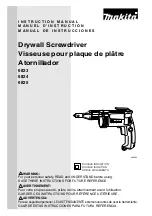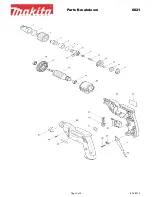
SKU 66118
For technical questions, please call 1-800-444-3353.
Page 3
a power tool will increase the risk of
electric shock.
personal safety
3.
Stay alert, watch what you are do-
a.
ing and use common sense when
operating a power tool. Do not use
a power tool while you are tired
or under the influence of drugs,
alcohol or medication.
A moment
of inattention while operating power
tools may result in serious personal
injury.
use personal protective equip-
b.
ment. always wear eye protection.
Safety equipment such as dust mask,
non-skid safety shoes, hard hat, or
hearing protection used for appropri-
ate conditions will reduce personal
injuries.
prevent unintentional starting.
c.
Carrying power tools with your finger
on the switch or energizing power
tools that have the switch on invites
accidents.
Remove any adjusting key or
d.
wrench before turning the power
tool on.
A wrench or a key left at-
tached to a rotating part of the power
tool may result in personal injury.
Do not overreach. Keep proper
e.
footing and balance at all times.
This enables better control of the
power tool in unexpected situations.
Dress properly. Do not wear loose
f.
clothing or jewelry. Keep your
hair, clothing and gloves away
from moving parts.
Loose clothes,
jewelry or long hair can be caught in
moving parts.
Only use safety equipment that
g.
has been approved by an appropri-
ate standards agency.
Unapproved
safety equipment may not provide
adequate protection. Eye protection
must be ANSI-approved and breath-
ing protection must be NIOSH-ap-
proved for the specific hazards in the
work area.
power tool use and care
4.
Do not force the power tool. use
a.
the correct power tool for your ap-
plication.
The correct power tool will
do the job better and safer at the rate
for which it was designed.
Do not use the power tool if the
b.
Direction Buttons (33) do not turn
it on and off.
Any power tool that
cannot be controlled with its switch
must not operated until it is repaired.
Disconnect the plug from the
c.
power source and/or remove the
Batteries (29) from the power tool
before making any adjustments,
changing accessories, or storing
power tools.
Such preventive safety
measures reduce the risk of starting
the power tool accidentally.
Store idle power tools out of the
d.
reach of children and do not allow
persons unfamiliar with the power
tool or these instructions to oper-
ate the power tool.
Power tools are
dangerous in the hands of untrained
users.
maintain power tools. Check for
e.
misalignment or binding of moving
parts, breakage of parts and any
other condition that may affect the
power tool’s operation. If dam-
aged, have the power tool repaired
before use.
Many accidents are
caused by poorly maintained power
tools.



























